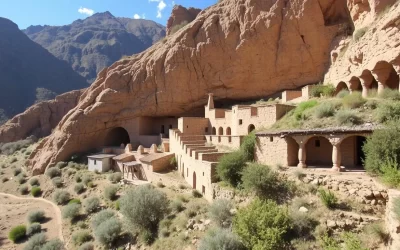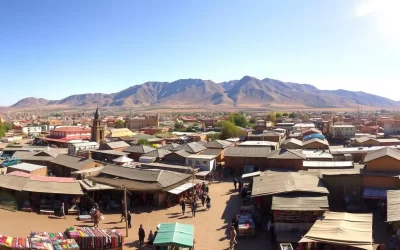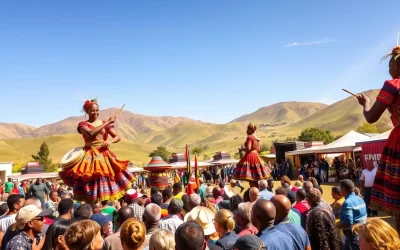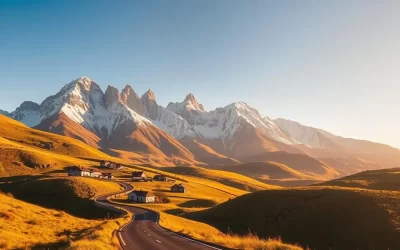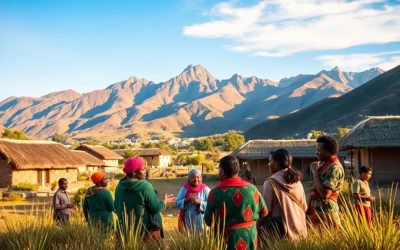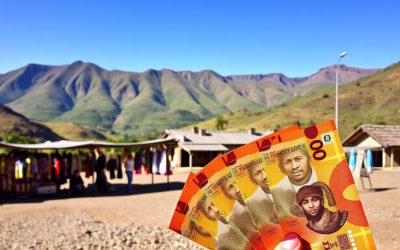Nestled in the heart of Southern Africa, a hidden gem awaits your discovery. With its rugged landscapes and rich cultural heritage, this mountainous kingdom offers an authentic African experience unlike any other.
As you plan your trip to this enchanting country, you’ll find that its unique charm lies in its remote villages, horsemen clad in traditional attire, and breathtaking natural beauty. Known as the “Kingdom in the Sky,” the country’s lowest point is over 1,400 meters above sea level, promising an unforgettable adventure amidst dramatic landscapes and cultural immersion opportunities.
When you visit this incredible country, you’ll be treated to a range of exciting things to experience, from historic fortresses to stunning waterfalls. Get ready to immerse yourself in the local culture and create lifelong memories in this captivating country.
Discovering the Mountain Kingdom of Lesotho
Nestled in the heart of southern Africa, Lesotho is a hidden gem waiting to be explored. As you discover the Mountain Kingdom, you’ll be drawn into its unique geography and cultural richness.
Geography and Location
Lesotho is an enclaved country, completely surrounded by South Africa. Its geography is characterized by high-altitude mountains, including the Maluti range, and deep valleys. The country’s rugged terrain makes it a paradise for hikers and adventure seekers. 
The diverse landscape supports a variety of flora and fauna, making Lesotho a fascinating destination for nature lovers.
Best Time to Visit Lesotho
Determining the best time to visit Lesotho largely depends on your interests. If you’re drawn to cultural events, plan your trip around the Morija Arts and Cultural Festival in September or Moshoeshoe’s Day Celebrations in March.
- For hiking and outdoor activities, consider visiting during the summer months (October to April) when the landscape is lush and green.
- If you’re interested in snow activities, winter (May to September) is the perfect time to visit Afriski Mountain Resort.
- Avoid the rainy season (December to February) if you plan to explore remote areas.
| Season | Best For | Weather |
|---|---|---|
| Summer (Oct to Apr) | Hiking, Outdoor Activities | Mild, Lush Green Landscapes |
| Winter (May to Sep) | Snow Activities, Skiing | Cold, Snowy Conditions |
| Rainy Season (Dec to Feb) | Avoid for Remote Areas | Heavy Rainfall |
Explore Thaba Bosiu: The Mountain Fortress

Thaba Bosiu, known as the Mountain Fortress, is a place you should visit to understand Lesotho’s history. This historical site is where King Moshoeshoe, the founder of the Basotho nation, established his stronghold in the early 19th century.
Historical Significance of King Moshoeshoe’s Stronghold
Thaba Bosiu served as a strategic stronghold for King Moshoeshoe, providing a secure refuge during times of conflict. The site is a testament to the king’s leadership and vision.
What to See at Thaba Bosiu
When you visit Thaba Bosiu, you can:
- Visit the interpretive center at the base of Thaba Bosiu to gain insights into the mountain’s historical significance before beginning your ascent.
- Explore the royal graves of King Moshoeshoe I and other Basotho leaders, which are important pilgrimage sites for local people.
- Discover the remains of stone fortifications and settlements on the plateau that date back to the 19th century.
- Take in the panoramic views from the summit, which offer spectacular vistas of the surrounding valleys and mountains.
- Engage with local guides who share fascinating stories and legends about the mountain, enhancing your understanding of its cultural importance.
This place is a must-visit when in Lesotho, offering a unique blend of history, culture, and natural beauty.
Visit Maseru: Lesotho’s Vibrant Capital

Maseru, Lesotho’s vibrant capital, is a city that seamlessly blends tradition with modernity. As you explore this captivating city, you’ll discover a rich cultural heritage and a unique blend of historical landmarks and contemporary attractions.
Maseru’s Main Attractions
Maseru offers a variety of attractions that showcase its history and culture. You can visit the iconic State House, explore the Katse Dam, or take a stroll along the scenic Caledon River.
Shopping at Basotho Hat and Local Markets
- Visit the iconic Basotho Hat building, a distinctive circular structure shaped like the traditional Basotho mokorotlo hat, which houses a craft center and market.
- Shop for authentic Basotho crafts including the famous Basotho blankets, intricately woven mohair products, pottery, and beadwork made by local artisans.
- Explore the Maseru Market where local vendors sell fresh produce, traditional foods, and everyday items, offering a glimpse into daily traditional Basotho life.
- Purchase a traditional Basotho hat (mokorotlo) as a practical souvenir that protects from both sun and rain while representing Basotho cultural identity.
- Interact with local craftspeople who are often willing to demonstrate their techniques and share stories about the cultural significance of their creations, connecting you with the people of Lesotho.
Experience Maletsunyane Falls and Abseiling

You can experience the thrill of abseiling down the world’s longest commercial rappel at Maletsunyane Falls. This adventure is a must-try for thrill-seekers visiting Lesotho.
The Spectacular Maletsunyane Waterfall
Maletsunyane Falls is a breathtaking 192-meter waterfall that creates a misty veil, surrounding the area with a mystical aura. The falls are surrounded by rugged terrain, making the experience even more exhilarating.
World Record Abseiling Adventure
The abseiling adventure at Maletsunyane Falls is a world-record experience. You will descend 204 meters alongside the falls, feeling the rush of adrenaline as you take in the stunning views. The activity is led by professional guides who ensure your safety throughout.
- Challenge yourself with the world’s longest commercial abseil (rappel) experience, descending 204 meters alongside the Maletsunyane Falls.
- Feel the adrenaline rush as you step off the edge and begin your controlled descent past the thundering waterfall, an experience that earned a Guinness World Record.
- Benefit from professional guides who provide comprehensive safety briefings, quality equipment, and expert supervision throughout this adventure activity.
- Enjoy spectacular views of the waterfall and gorge from a perspective few get to experience, making for unforgettable photos and memories.
- Complete this bucket-list adventure that attracts thrill-seekers from around the world to this remote corner of Lesotho.
Explore Sehlabathebe National Park

Sehlabathebe National Park, a UNESCO World Heritage Site, offers an unparalleled wilderness experience in the mountain kingdom of Lesotho. This park is a haven for those who seek to immerse themselves in nature.
UNESCO World Heritage Site Features
The park boasts unique features that have earned it a UNESCO World Heritage designation. You can explore the diverse landscapes, from grasslands to wetlands, and witness the rich cultural heritage of the area. The park’s high-altitude environment is home to numerous rare species.
Wildlife and Hiking Opportunities
You can spot unique high-altitude wildlife, including the rare Maloti minnow and bearded vulture. The park’s extensive network of hiking trails allows you to explore diverse landscapes. You can also experience the freedom of hiking without designated trails and enjoy the spectacular wildflowers that bloom in spring and summer.
Discover Ts’ehlanyane National Park

Immerse yourself in the breathtaking landscapes of Ts’ehlanyane National Park, one of Lesotho’s most prized natural reserves. This park is a haven for those who seek to experience the great outdoors.
Indigenous Forest and Mountain Scenery
Ts’ehlanyane National Park boasts an indigenous forest and stunning mountain scenery, making it a unique destination for nature enthusiasts. The park’s diverse landscapes offer a glimpse into Lesotho’s natural beauty.
Activities in Ts’ehlanyane
You can enjoy a variety of activities in Ts’ehlanyane National Park, including:
- Hike the network of well-maintained trails ranging from easy walks to challenging full-day treks, allowing visitors of all fitness levels to experience the park’s beauty.
- Try mountain biking on designated routes that wind through varied terrain, offering both technical challenges and scenic rewards.
- Cool off in natural swimming pools formed by the Holomo and Ts’ehlanyane rivers, a refreshing activity during summer months.
- Participate in guided nature walks led by knowledgeable local rangers who share insights about the park’s flora, fauna, and cultural significance.
- Enjoy bird watching opportunities with over 220 bird species recorded in the park, including the rare Drakensberg siskin and mountain pipit.
With its diverse range of activities and breathtaking scenery, Ts’ehlanyane National Park is an ideal destination for outdoor enthusiasts looking to experience Lesotho’s natural beauty.
Visit Bokong Nature Reserve

As the highest nature reserve in Africa, Bokong Nature Reserve presents an unparalleled opportunity to explore Lesotho’s rich biodiversity. Located in the Maluti Mountains, this reserve is a haven for those interested in wildlife and conservation.
The Highest Nature Reserve in Africa
Bokong Nature Reserve is distinguished by its high-altitude terrain, offering breathtaking views and a unique environment that supports a variety of flora and fauna. The reserve’s elevation makes it an ideal location for spotting wildlife adapted to high-altitude environments.
Vulture Restaurant and Wildlife Viewing
The reserve is famous for its “vulture restaurant,” a feeding station that supports the endangered bearded vulture (lammergeier) and Cape vulture populations. You can:
- Visit the famous “vulture restaurant,” a feeding station established to support the endangered bearded vulture and Cape vulture populations.
- Learn about conservation efforts to protect these magnificent birds of prey.
- Spot wildlife such as baboons, rock hyrax, and various antelope species.
- Participate in guided wildlife viewing walks led by knowledgeable local rangers.
- Bring binoculars to enhance your wildlife viewing experience.
When you visit Bokong Nature Reserve, you are not only treated to stunning natural beauty but also contribute to the conservation of Lesotho’s unique biodiversity.
Immerse in Basotho Culture and Village Life

Visiting Lesotho provides an opportunity to delve into the traditional life and customs of the Basotho. You will be immersed in a world of cultural richness through various celebrations and traditions.
Traditional Village Homestays
Experience Basotho village life firsthand by staying with local families. You can participate in daily activities such as farming, cooking, and crafting, gaining a deeper understanding of the Basotho way of life.
Learning About Basotho Traditions
During your stay, you can learn about the significance of the Basotho blanket, a cultural icon worn by men and women. You can also participate in traditional music and dance sessions, and discover crafts like grass weaving and pottery.
By engaging with the local culture, you will gain insights into the spiritual beliefs, social structures, and customs that have shaped Basotho life for generations.
Attend Lesotho’s Cultural Festivals

Immerse yourself in Lesotho’s culture by attending one of its many festivals, a true reflection of the country’s spirit. Lesotho’s cultural festivals are a celebration of its rich heritage and history.
Morija Arts and Cultural Festival
The Morija Arts and Cultural Festival is a highlight of Lesotho’s cultural calendar, showcasing the country’s music, dance, and art. This annual event attracts visitors from across the region, offering a unique opportunity to experience Basotho culture firsthand. You can enjoy traditional performances, local cuisine, and handicrafts.
Moshoeshoe’s Day and Independence Day Celebrations
Lesotho’s national holidays, Moshoeshoe’s Day on March 11th and Independence Day on October 4th, are significant cultural events. Moshoeshoe’s Day honors the legacy of King Moshoeshoe I, the founder of the Basotho nation, while Independence Day commemorates the country’s independence from British rule. You can witness traditional ceremonies, historical reenactments, and cultural performances that showcase national pride and unity.
Join the celebrations to experience the country’s sovereignty and the Basotho people’s rich cultural heritage.
Lesotho: Best Things to Do for Adventure Seekers
If you’re an adventure enthusiast, Lesotho has plenty to offer with its diverse outdoor activities. The country’s rugged terrain and breathtaking landscapes make it an ideal destination for thrill-seekers.
Pony Trekking Through Mountain Trails
Pony trekking is a great way to explore Lesotho’s scenic trails. You can take guided tours that allow you to experience the beauty of the mountain kingdom.

Mountain Biking and Hiking Adventures
Lesotho offers exciting opportunities for mountain biking and hiking. You can challenge yourself with mountain biking on rugged terrain or explore the extensive network of hiking trails.
- Challenge yourself with mountain biking on Lesotho’s rugged terrain, with routes ranging from technical single-track to more leisurely gravel roads.
- Participate in the annual Lesotho Sky Mountain Bike Race, a six-day stage race that attracts international competitors.
- Explore Lesotho’s extensive network of hiking trails, from day hikes around major attractions to multi-day treks through remote mountain areas.
- Experience the freedom of hiking in a country where much of the landscape remains undeveloped.
- Plan your adventure trip with local operators who provide equipment, guides, and logistical support.
Whether you’re into mountain biking, hiking, or pony trekking, Lesotho has something for every adventure enthusiast. Make sure to plan your trip with local experts to get the most out of your experience.
Discover Ancient Rock Art and Historical Sites

The country of Lesotho boasts an impressive collection of ancient rock art, offering insights into the spiritual and daily lives of its original inhabitants.
Ha Baroana and Other Rock Art Locations
Lesotho is home to numerous rock art sites, with Ha Baroana being one of the most significant. You can explore these sites to learn about the San people, their hunter-gatherer lifestyle, and their deep spiritual connection to the land.
- Learn about the San people who created the rock art.
- Understand the significance of these art forms in their culture.
Interpreting Lesotho’s Ancient History
The art found in these rock shelters serves as a window into the past, allowing archaeologists and anthropologists to reconstruct the history and beliefs of prehistoric communities in this country.
- Discover how these ancient images are interpreted.
- Explore the impact of Bantu-speaking peoples and European colonizers on the San.
- Appreciate efforts to preserve these cultural treasures.
Winter Activities: Skiing in Africa

Skiing in Lesotho is an adventure like no other, thanks to Afriski Mountain Resort. You can enjoy a variety of winter activities in the heart of Africa.
Afriski Mountain Resort
Afriski Mountain Resort is Lesotho’s premier destination for skiing and other winter sports. Located in the Maluti Mountains, it offers a unique skiing experience with slopes for different skill levels. The resort is equipped with snow-making equipment to ensure good snow conditions throughout the winter season.
Winter Sports Season and Activities
The winter sports season at Afriski runs from June to August. During this time, you can participate in various activities such as skiing, snowboarding, tubing, and snow biking. The resort hosts events and competitions, creating a lively atmosphere. Beyond skiing, Afriski offers year-round activities like mountain biking and hiking, popular among athletes from South Africa. Plan your visit at the right time to make the most of your trip.
Conclusion: Planning Your Unforgettable Lesotho Adventure
With its unique blend of adventure, culture, and natural wonders, Lesotho is a destination that promises an unforgettable experience. As you plan your visit to this Mountain Kingdom, consider the diverse experiences it offers, from cultural immersion and historical exploration to adventure activities and breathtaking natural beauty.
The best time to visit Lesotho depends on your interests, whether it’s summer for hiking and cultural festivals or winter for the unique experience of skiing in Africa. Carefully plan your trip to Lesotho, including transportation, accommodation options ranging from international hotels to rural homestays, and hiring local guides.
Embracing the local culture and connecting with the Basotho people will enrich your journey, making your Lesotho adventure not just a trip but a life-enriching experience. With its authentic experiences, stunning landscapes, and warm hospitality, Lesotho is a country that will leave you with memories to last a lifetime.
The above is subject to change.
Check back often to TRAVEL.COM for the latest travel tips and deals.

